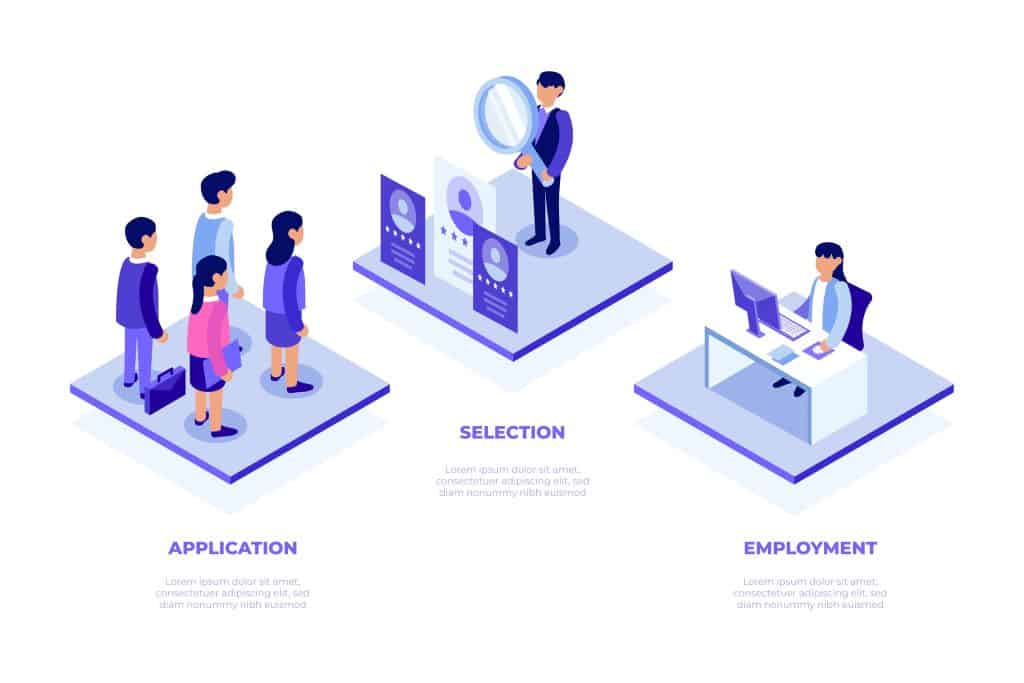The worldwide acceptance of the remote working model has changed the way companies utilize their hiring strategies. The increasing trend of remote working has benefited both employees and employers. However, along with offering the advantages, there are certain remote hiring challenges that are to be overcome by both sides for greater effectiveness while working remotely. Organizations need to develop strategies that help them get better employee engagement without exhausting the employees and in turn, employees also need to give their best to the organization outside the conventional office along with balancing their personal life. This blog here lists the remote hiring challenges that employees and employers face and will help you understand and encounter them readily.
Remote Hiring Challenges Faced by the Organizations
- Blurred Work-Life Boundaries
One of the main misconceptions about remote work is that hiring remote employees will reduce productivity for the organization as the employees sometimes behave lazily and start procrastinating the work without making it a priority. While the opposite tends to be the reality and becomes one of the remote hiring challenges that employees tend to face: remote workers are more likely to overwork. The sudden invasion of the remote working environment in their lives blurs the life between work and life if not handled or managed properly. When personal life and work come under the same roof it becomes tough for some to switch to one another from time to time, causing a stressed atmosphere.
Solution: It becomes the employer’s responsibility to take the initiative to ensure that he is not extending the working hours for his remote team. The work can be prioritized to avoid the extra working hours and any non-essential conversations or tasks should be avoided. Timely communication with remote employees is a must in order to simplify the execution of tasks to avoid any delays. - Lack of Positive Supervision:
One of the most important concerns for remote workers is the lack of positive supervision by the seniors or the managers. Moreover, sometimes the managers even lack trust in their remote employees regarding their working style. They practice techniques like mandatory live cam monitoring, frequent reporting, or maintaining strict time sheets to monitor their daily activities. However, these activities can negatively impact employee-employer relations and can lead to serious trust issues, and can create a major trust rift between them.
Solution: While some level of supervision is acceptable and required, caution must be taken to use only minimally intrusive monitoring tools. Employers can consider implementing goal-oriented KPIs (KPIs) to track employee performance but in progressive ways. - Lack of human interaction and feeling left alone
Humans are social animals, they like to interact with each other, however, remote workers working away from traditional office spaces have less interaction with their colleagues. These isolations can lead to prolonged feelings of being alone can lead to the feeling of being left alone and can play with their mental health.
Apart from the harm to mental health, employee isolation can also cause breakdowns in-group cohesion very quickly. The outcome could potentially affect the overall performance in particular areas, which would unfairly place the blame on each other. This is by far one of the most important remote hiring challenges that hiring managers need to take into consideration.
Solution: Besides the core meeting groups, the employees can try to communicate on various communication tools like Slack, Teams, etc. for a better understanding between them. They should be allowed to communicate freely using private channels and utilize other communication facilities like voice and video calls. These will lead to better team-building and can help them foster great collaboration among them. The employer can also engage its employees in some social activities from time to time to lighten their minds. - Facing Frequent Technical Glitches
The worst nightmare any remote worker fears is having internet outages or technical glitches in the middle of work. A stable and fast internet connection is a must-have for remote workers; however, sometimes technical issues can hinder their productivity.
It is not always necessary that there is always a major complex issue that leads to some struggle but sometimes minor glitches can also make it difficult for them to handle the application functionality, especially for people from non-technical backgrounds.
Solutions: It is obvious that it is not always possible for every organization to have a technical support team to support remote workers. But organizations can try to train their remote staff with the digital tools that they frequently have to deal with. The training may include a detailed explanation of how to handle technical difficulties so that it won’t hinder their work productivity and when to contact the technical team if issues persist.
The employee can also make sure they have a proper backup if the problem appears from their end. They should have a backup computer or tablet in case an issue comes in their laptops. Having a power backup is also a necessity for a remote working employee. - Communication Gap and Being Out of Loop
While any professional communication for any organization generally happens through emails, there are high chances of getting misunderstood if the subject and the content are not well defined. These small misunderstandings can create major issues if not resolved amicably.
The other point that makes good communication a major point while hiring remote employees is that all the work and the productivity of the team depends on how they connect and collaborate with each other. If any of the employees of the team is of introverted nature or has some issues communicating with others may be due to some language barrier or some other issues, it can disturb the balance of the whole team. Thus, remote work needs extra care for better communication.
Solution: The team should be made free to communicate with each other anytime. The teammates should try to clarify each and every detail with each other to avoid any misunderstandings. The managers should take this into consideration so that no one feels out of the loop if any major team decisions are taken.
Remote Hiring Challenges Faced by the employees:
- Time Zone Differences
One of the major remote hiring challenges that any recruiter’s faces is the time zone barrier. Although remote hiring offers a global talent pool for organizations to find prospective candidate from around the world by eliminating location barriers. This geographical freedom sometimes becomes a major issue when it comes to connecting with teammates due to time zone differences. It can cause inconvenience in scheduling team meetings or conducting real-time calls. Sometimes, it can lead to misunderstandings also between teammates and that can affect the working of the entire team.
Solution: It is the responsibility of hiring managers to optimize the time zone overlaps while scheduling meetings or calls. They can opt for some automatic scheduling tools to match the team’s time zones. These tools can help them choose the time that works best for everyone without creating any issues for anyone. This can help them eliminate the productive gaps due to time errors. - High Vulnerability to Cyber Security Threats
Being remote means having a workforce that is completely dependent upon the digital world. This increases the vulnerability of the organization’s infrastructure to cyber security threats. If the company’s centralized remote servers become vulnerable to such incidents, it can affect the organization in a very expensive manner. These incidents can cause data loss, and privacy breaches for the organization as well as employees and can sometimes lead to a financial or reputational loss for the organization.
Solutions: There is a broad range of solutions that organizations can adopt to address such cyber security threats. They can consider hiring an external cyber security experts’ team or can have an internal team to timely keep a watch on the organization’s cyber health. Apart from these organizations can utilize various security tools like Internet security applications, password managers, or VPNs (Virtual Private Networks) to secure their networks and lower the risks. - Onboarding difficulties
Onboarding new employees in a virtual manner can be a bit tricky. For any new joiner, the first day of office is somewhat always exciting. They need to understand the workflow and office culture, so it becomes important for them to have a proper onboarding and training process. It has always been observed in remote hiring that newly hired employees tend to be more productive if given proper training and comfort in the first month of the job.
A proper and formal introduction to the team he is going to work with also plays an important role in making the employee comfortable and happy in the new space.
Solution: It becomes the responsibility of the hiring managers to put extra effort to establish a smooth onboarding process for a newly hired remote employee to enhance his learning. He can plan and organize introductory sessions with new joiners and can explain to him the workflows and processes. This helps to build a healthy and transparent company culture. - Mis-matched Collaboration of the Team
One of the most fundamental and most faced remote hiring challenges that arise is the high chances of getting misaligned collaboration and performance of the team. Realistically, this occurs even while working from the office, although in remote settings the risk may increase when there is less interaction between workers and managers.
However, maintaining the proper levels of supervision and responsibility without placing undue strain on personnel presents a more serious challenge. It’s important to realize, though, that if not adequately monitored, excessive dependence on these technical tools can swiftly degenerate into chaos and can lead to mismatching performances.
Solution: The organizations can adopt cloud-based platforms for the teams to communicate and collaborate. These platforms are highly capable of resolving the collaboration problems between the team members which can ensure smooth functioning and better participation of every team member. - Lower Rates of Employee Retention
Even while working from home seems like it would offer employees enough freedom and flexibility to keep them on board, for many people it can still be difficult. Hiring managers are likely to face lower rates of employee retention as one of the major remote hiring challenges. Remote workers are prone to feeling lonely. That occasionally results in a lack of connection with their co-workers. Some people who telecommute could feel under additional pressure. Some employees can feel the urge to leave your firm in favor of one that will make them happier if it becomes too much for them.
Solutions: Take steps to make sure your team can maintain a healthy work-life balance to prevent a high turnover rate. Make sure to keep the team in touch through virtual conferences, virtual water coolers, prizes, praises, and congratulations, among other things. Any remote worker is more likely to want to stick around if the organization can make them feel valued, respected, and ultimately included.
Conclusion:
These are just a few remote hiring challenges that remote-working employees and hiring managers generally face. However, if proper attention is not paid to them, they can affect the teams as well as the organization’s success. However, it becomes the responsibility of both parties to ensure that no work efficiency is lost from both ends, due to whatsoever reason. Both the employees and the employers need to make sure they have enough ways to overcome such challenges so that it doesn’t affect their respective priorities.
Frequently Asked Questions
- What is remote work?
Remote work is when an employee performs his duty from outside of the traditional office space may it be his home or any other place. Refer to https://bridgentech.com/the-concept-of-remote-work-explained/ for detailed knowledge about remote work. - Who are Remote workers?
Remote workers are those who perform their official duties outside of the traditional office spaces. They do not commute to work daily and are generally working from their homes. - What are common mistakes that companies need to avoid if they don’t want to face any remote hiring challenges?
The companies could take into consideration several remote hiring mistakes that could help them avoid certain remote hiring challenges like avoiding overburdening the employees, making proper communication between the teams, investing in good technologies, etc. - How can I hire remote workers?
Several remote staffing agencies can help you hire remote workers easily. One such is Bridgentech. Contact Bridgentch at info@bridgentech.com








